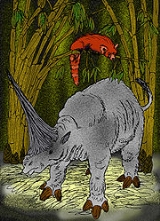
Sinotherium
Encyclopedia
Sinotherium was a genus of single-horned rhinoceri of the late Miocene
and Pliocene
. It was ancestral to Elasmotherium
, and its fossils have been found in western China.
Sinotherium diverged from the ancestral genus, Iranotherium
, first found in Iran
, during the early Pliocene. Some experts prefer to lump Sinotherium, and Iranotherium into Elasmotherium.
Its synonym, "Paraelasmotherium
," is often used to refer to the Miocene specimens.
Miocene
The Miocene is a geological epoch of the Neogene Period and extends from about . The Miocene was named by Sir Charles Lyell. Its name comes from the Greek words and and means "less recent" because it has 18% fewer modern sea invertebrates than the Pliocene. The Miocene follows the Oligocene...
and Pliocene
Pliocene
The Pliocene Epoch is the period in the geologic timescale that extends from 5.332 million to 2.588 million years before present. It is the second and youngest epoch of the Neogene Period in the Cenozoic Era. The Pliocene follows the Miocene Epoch and is followed by the Pleistocene Epoch...
. It was ancestral to Elasmotherium
Elasmotherium
Elasmotherium is an extinct genus of giant rhinoceros endemic to Eurasia during the Late Pliocene through the Pleistocene, documented from 2.6 mya to as late as 50,000 years ago, possibly later, in the Late Pleistocene, an approximate span of slightly less than 2.6 million years. Three species...
, and its fossils have been found in western China.
Sinotherium diverged from the ancestral genus, Iranotherium
Iranotherium
Iranotherium was a large elasmothere rhinoceros, as big as a modern white rhino, found in Central Asia. It was a precursor of the related Sinotherium, and may have been ultimately outcompeted by its descendant....
, first found in Iran
Iran
Iran , officially the Islamic Republic of Iran , is a country in Southern and Western Asia. The name "Iran" has been in use natively since the Sassanian era and came into use internationally in 1935, before which the country was known to the Western world as Persia...
, during the early Pliocene. Some experts prefer to lump Sinotherium, and Iranotherium into Elasmotherium.
Its synonym, "Paraelasmotherium
Elasmotherium
Elasmotherium is an extinct genus of giant rhinoceros endemic to Eurasia during the Late Pliocene through the Pleistocene, documented from 2.6 mya to as late as 50,000 years ago, possibly later, in the Late Pleistocene, an approximate span of slightly less than 2.6 million years. Three species...
," is often used to refer to the Miocene specimens.
External links
- "Elasmotherians- Evolution, Distribution, and Ecology" http://www.cq.rm.cnr.it/elephants2001/pdf/126_128.pdf
- Mikko's Phylogeny Archive, "Rhinocerotidae: †Elasmotheriinae: †Elasmotheriini: †Elasmotheriina" http://www.fmnh.helsinki.fi/users/haaramo/Metazoa/Deuterostoma/Chordata/synapsida/Eutheria/Perissodactyla/Rhinocerotidae/Elasmotheriini.html
- New Remains of Paraelasmotherium (Perissodactyla. Rhinocerotidae) from the Miocene in Dongxiang Stidy. Gansu, China http://www.wanfangdata.com.cn/qikan/periodical.Articles/gjzdwxb/gjzd2001/0104/010408.htm

